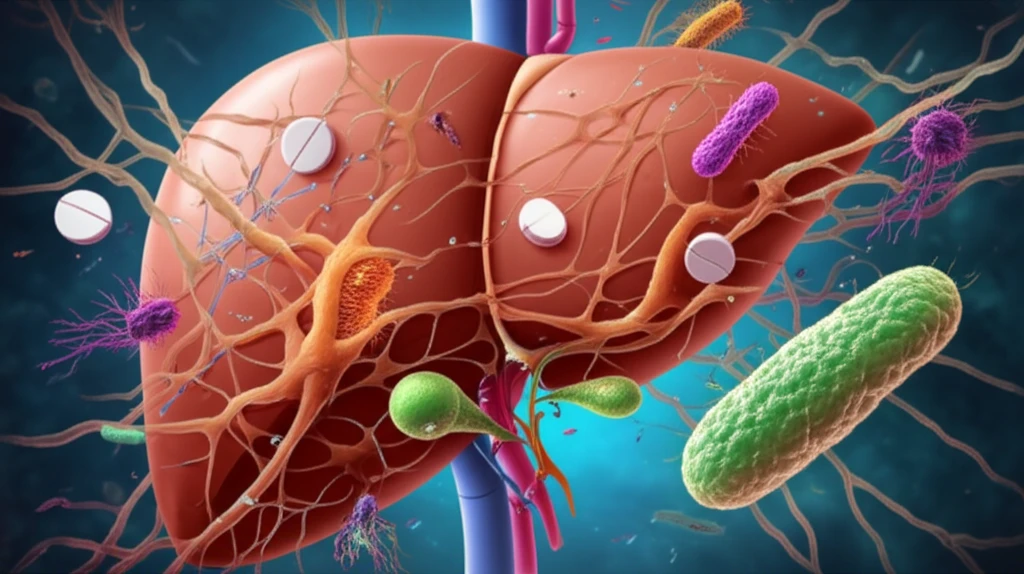
Gut Check: When 'Good' Bacteria Turns Bad in Liver Disease
"A rare case highlights how common gut bacteria can cause serious infections in patients with cirrhosis, and what preventative measures might backfire."
Spontaneous bacterial peritonitis (SBP) is a serious infection common in individuals with cirrhosis, a condition where the liver becomes scarred and damaged. Affecting 10% to 30% of cirrhotic patients with ascites (fluid buildup in the abdomen), SBP is associated with high morbidity and mortality rates. The risk of recurrence is also very high, making prevention a key concern for doctors and patients.
To prevent SBP, doctors often prescribe selective intestinal decontamination (SID) using antibiotics like quinolones or trimethoprim/sulfamethoxazole. These medications aim to reduce the number of harmful bacteria in the gut. However, this approach isn't without its risks. By targeting certain bacteria, SID can inadvertently create an environment where resistant strains flourish, including some gram-positive cocci.
Enterococci, normally present in the gut, are generally harmless. However, certain species like E. faecalis and E. faecium can become opportunistic pathogens, particularly in hospital settings. While other enterococcal species are less frequently implicated in human infections, their role is increasingly recognized. This article explores a rare and potentially life-threatening instance of SBP caused by Enterococcus hirae in a patient with cirrhosis, offering insights into the delicate balance of gut bacteria and the potential consequences of antibiotic use.
The Case of the Unexpected Infection

A 61-year-old male with a history of alcoholic liver cirrhosis and type 2 diabetes was admitted to the emergency room. His symptoms included abdominal pain, fever, chills, and general weakness. He had previously been treated for SBP caused by Klebsiella pneumoniae and was on a regimen of norfloxacin (a quinolone antibiotic) to prevent recurrence.
- Initial Treatment: The patient was started on intravenous cefotaxime, a broad-spectrum antibiotic.
- Lack of Improvement: Despite antibiotic treatment, the patient's condition worsened, with persistent fever and elevated inflammatory markers.
- Identification of the Culprit: Cultures from both ascitic fluid and blood revealed gram-positive cocci, identified as Enterococcus hirae.
- Change in Antibiotics: The antibiotic regimen was switched to vancomycin and ciprofloxacin to target the identified bacteria.
- Positive Outcome: The patient's fever subsided, and laboratory findings gradually improved. He was later discharged without complications after treatment with intravenous ampicillin, guided by antibiotic sensitivity testing.
The Delicate Balance: Lessons Learned
This case highlights several key issues in the management of SBP. First, it demonstrates that while SID with antibiotics can be effective in preventing SBP, it can also disrupt the natural balance of gut bacteria. This disruption can lead to the selection of resistant organisms, including unusual pathogens like E. hirae.
Second, the case underscores the need for vigilance in patients with cirrhosis who develop infections. When initial antibiotic treatment fails, it's crucial to consider the possibility of resistant or unusual organisms and to perform appropriate cultures to identify the causative agent. Antibiotic stewardship, or the responsible use of antibiotics, is essential to minimize the development of resistance.
Finally, this case serves as a reminder of the complex interplay between the gut microbiome, antibiotic use, and infection risk in vulnerable populations like patients with cirrhosis. Further research is needed to better understand these interactions and to develop strategies to prevent SBP without promoting antibiotic resistance.
